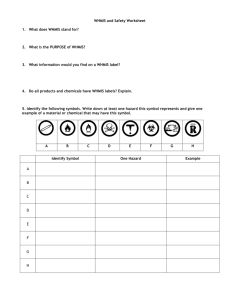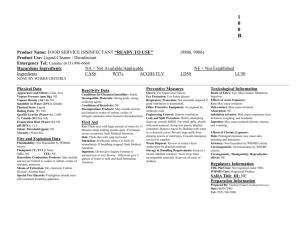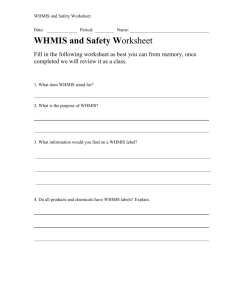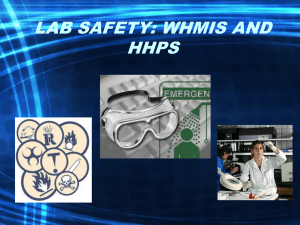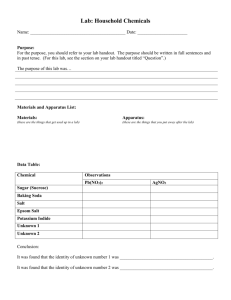WHMIS 2015 - Canadian Centre for Occupational Health and Safety
advertisement
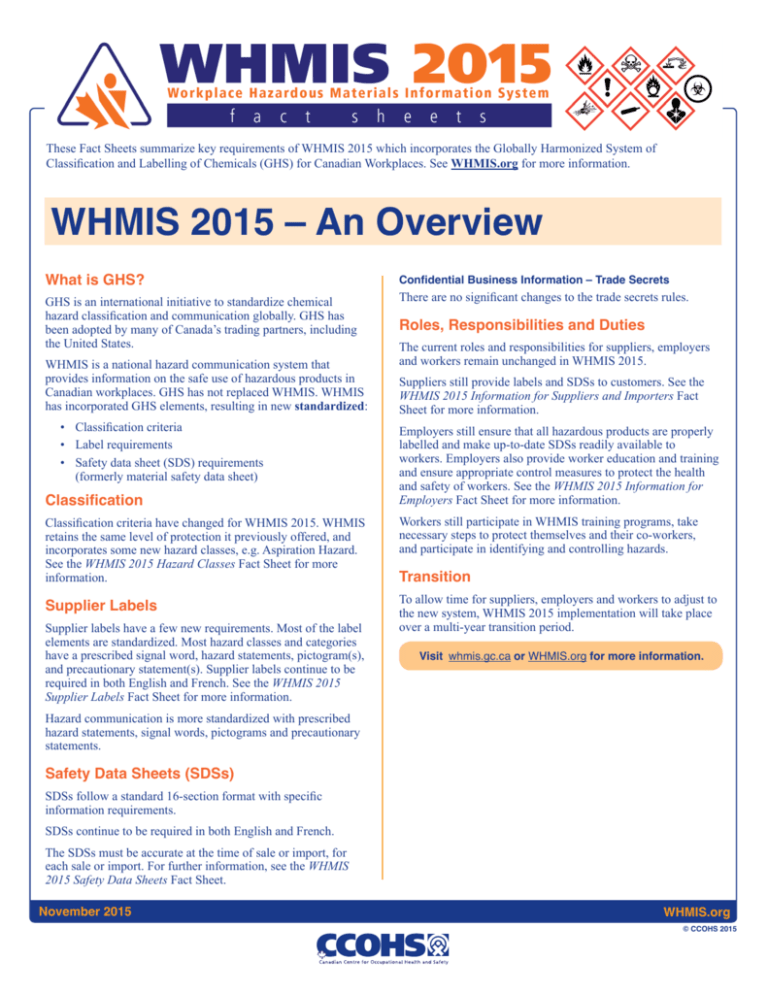
These Fact Sheets summarize key requirements of WHMIS 2015 which incorporates the Globally Harmonized System of Classification and Labelling of Chemicals (GHS) for Canadian Workplaces. See WHMIS.org for more information. WHMIS 2015 – An Overview What is GHS? Confidential Business Information – Trade Secrets GHS is an international initiative to standardize chemical hazard classification and communication globally. GHS has been adopted by many of Canada’s trading partners, including the United States. Roles, Responsibilities and Duties WHMIS is a national hazard communication system that provides information on the safe use of hazardous products in Canadian workplaces. GHS has not replaced WHMIS. WHMIS has incorporated GHS elements, resulting in new standardized: • Classification criteria • Label requirements • Safety data sheet (SDS) requirements (formerly material safety data sheet) Classification There are no significant changes to the trade secrets rules. The current roles and responsibilities for suppliers, employers and workers remain unchanged in WHMIS 2015. Suppliers still provide labels and SDSs to customers. See the WHMIS 2015 Information for Suppliers and Importers Fact Sheet for more information. Employers still ensure that all hazardous products are properly labelled and make up-to-date SDSs readily available to workers. Employers also provide worker education and training and ensure appropriate control measures to protect the health and safety of workers. See the WHMIS 2015 Information for Employers Fact Sheet for more information. Classification criteria have changed for WHMIS 2015. WHMIS retains the same level of protection it previously offered, and incorporates some new hazard classes, e.g. Aspiration Hazard. See the WHMIS 2015 Hazard Classes Fact Sheet for more information. Workers still participate in WHMIS training programs, take necessary steps to protect themselves and their co-workers, and participate in identifying and controlling hazards. Supplier Labels To allow time for suppliers, employers and workers to adjust to the new system, WHMIS 2015 implementation will take place over a multi-year transition period. Supplier labels have a few new requirements. Most of the label elements are standardized. Most hazard classes and categories have a prescribed signal word, hazard statements, pictogram(s), and precautionary statement(s). Supplier labels continue to be required in both English and French. See the WHMIS 2015 Supplier Labels Fact Sheet for more information. Transition Visit whmis.gc.ca or WHMIS.org for more information. Hazard communication is more standardized with prescribed hazard statements, signal words, pictograms and precautionary statements. Safety Data Sheets (SDSs) SDSs follow a standard 16-section format with specific information requirements. SDSs continue to be required in both English and French. The SDSs must be accurate at the time of sale or import, for each sale or import. For further information, see the WHMIS 2015 Safety Data Sheets Fact Sheet. February 2015 November 2015 WHMIS.org WHMIS.org © CCOHS 2015 These Fact Sheets summarize key requirements of WHMIS 2015 which incorporates the Globally Harmonized System of Classification and Labelling of Chemicals (GHS) for Canadian Workplaces. See WHMIS.org for more information. Information for Suppliers and Importers The implementation of GHS in WHMIS will help Canada’s hazard communication system to be more aligned with those of other countries. The benefits include a globally standardized approach for hazard classification and hazard communication (supplier labels and Safety Data Sheets (SDSs)). Supplier and Importer Responsibilities Under WHMIS 2015, suppliers will continue to: • Ensure the appropriate classification of hazardous products • Provide labels • Provide SDSs (formerly MSDSs) Classification WHMIS 2015 has many hazard classes. WHMIS 2015 incorporates physical and health hazard classes from the GHS and retains the Biohazardous Infectious Materials hazard class. WHMIS 2015 also introduces hazard classes for Pyrophoric Gases, Simple Asphyxiants, and Combustible Dusts, which are not covered in the GHS. The hazard classes contain “categories” or “types” which reflect varying degrees of hazard. See the WHMIS 2015 Hazard Classes Fact Sheet for more information on hazard classes. To prepare to classify a product, suppliers should: 1. Obtain a copy of the criteria. 2. Identify the relevant hazard data for products. 3. Review the data in light of the classification criteria to determine the appropriate hazard classes and categories. Note that there is specific guidance for classifying mixtures for health hazards. 4. Document the rationale and information for future reference. Classification must be determined based on comparison of all available hazard data to the criteria in the regulations. The data used must be scientifically sound and valid. February 2015 November 2015 Hazard Communication Supplier Labels and Safety Data Sheets Hazard communication is more standardized with prescribed pictograms, signal words, hazard statements, and precautionary statements. Supplier Labels Most of the label elements will be standardized. Most hazard classes and categories have a prescribed signal word, hazard statement, precautionary statements and pictogram. English and French continue to be required. See the WHMIS 2015 Supplier Labels Fact Sheet for further information. Safety Data Sheets SDSs will use a standard 16-section format. There are some new information requirements. For example, the WHMIS classification, hazard statements and other label elements are required in Section 2. The SDSs must be accurate at the time of sale or import, for each sale or import. For further information, see the WHMIS 2015 Safety Data Sheets Fact Sheet. Confidential Business Information – Trade Secrets There are no significant changes to the trade secrets rules. WHMIS 2015 is based on the 5th revised edition of the GHS. Visit whmis.gc.ca or WHMIS.org for more information. WHMIS 2015 Transition As of February 11, 2015 suppliers must fully comply with either the WHMIS 1988 or WHMIS 2015 requirements for a specific controlled or hazardous product. The classification, label and (M)SDS must comply fully with the specific regulation chosen by the supplier, and not be a combination of the two. Suppliers choosing to use WHMIS 1988 must also follow requirements such as updating MSDSs every three years or when information has changed. WHMIS.org WHMIS.org © CCOHS 2015 These Fact Sheets summarize key requirements of WHMIS 2015 which incorporates the Globally Harmonized System of Classification and Labelling of Chemicals (GHS) for Canadian Workplaces. See WHMIS.org for more information. Information Information for for Employers Employers The implementation of GHS in WHMIS will help Canada’s hazard communication system to be more aligned with those of other countries. The benefits include a globally standardized approach for hazard classification and hazard communication (labels and Safety Data Sheets (SDSs)). Employers’ Duties Under WHMIS 2015, employers must continue to: • Educate and train workers on the hazards and safe use of products. • Ensure that hazardous products are properly labelled. • Prepare workplace labels and SDSs as necessary. • Provide access for workers to up-to-date SDSs. • Review the education and training provided to employees annually or whenever work conditions or hazard information changes. Supplier Labels New requirements for supplier labels include signal words, and standardized hazard statements and precautionary statements. Most hazard classes and categories have a prescribed signal word, hazard statement and pictogram. Supplier labels continue to be required in both English and French. See the WHMIS 2015 Supplier Labels Fact Sheet for further information. The preparation of workplace labels is still required. Safety Data Sheets (SDSs) SDSs must follow a standard 16-section format. There are some new information requirements, for example, inclusion of the WHMIS classification, hazard statements and other label elements in Section 2. For further information, see the WHMIS 2015 Safety Data Sheets Fact Sheet. Worker Education and Training SDSs will be updated when significant new data become available. Employers are required to educate and train workers about WHMIS 2015. Revised education and training programs, developed in consultation with the health and safety committee, will include: Worker access to SDSs is a continuing requirement. Ensure that updated SDSs are obtained for all hazardous products used in the workplace. • New hazard pictograms. • New hazard classes. • New labels and their required elements such as signal words. • The meaning of all signal words and hazard statements found on labels and SDSs in the workplace, such as Danger - May cause cancer. • The new SDS format and how to locate information needed to work safely with a product. • Worksite-specific training on measures to work safely with hazardous products. See related WHMIS 2015 Fact Sheets for information on these topics. With WHMIS 2015, SDSs and labels for products originating within and outside of Canada will share common elements. This will simplify education and training. February 2015 November 2015 Confidential Business Information – Trade Secrets There are no significant changes to the trade secrets rules. For more information on the WHMIS requirements in your jurisdiction visit WHMIS.org. WHMIS 2015 Transition Employers are required to educate and train workers about WHMIS 2015 as new labels and SDSs will appear in their workplaces. During the transition period, employers may continue to have WHMIS 1988 labels and MSDSs in the workplace - if so, they must also continue to educate workers about WHMIS 1988. Employers must review and comply with the WHMIS requirements of their OSH jurisdiction. TIP – SDSs now provide hazard classifications for hazardous products in your workplace, which will support workplace education and training. WHMIS.org WHMIS.org © CCOHS 2015 These Fact Sheets summarize key requirements of WHMIS 2015 which incorporates the Globally Harmonized System of Classification and Labelling of Chemicals (GHS) for Canadian Workplaces. See WHMIS.org for more information. Pictograms Hazards Informationand forTheir Employers WHMIS 2015 Types of Hazards Gases under pressure Flammables (gases, aerosols, liquids, solids), Pyrophoric (liquids, solids, gases), Self-reactive substances and mixtures, Self-heating substances and mixtures, Substances and mixtures which, in contact with water, emit flammable gases, Organic peroxides Oxidizing (liquids, solids, gases) Acute toxicity (fatal or toxic) Carcinogenicity, Germ cell mutagenicity, Respiratory sensitization, Reproductive toxicity, Specific target organ toxicity - single exposure, Specific target organ toxicity - repeated exposure, Aspiration hazard Acute toxicity (harmful), Skin irritation, Eye irritation, Skin sensitization, Specific target organ toxicity - single exposure (respiratory irritation or drowsiness or dizziness) Corrosive to metals, Skin corrosion, Serious eye damage Self-reactive substances and mixtures, Organic peroxides Biohazardous infectious materials WHMIS 2015 does not incorporate the GHS Explosives and Environmental Hazard Classes. Explosives Hazardous to the aquatic environment Hazardous to the ozone layer The requirements for pictograms are based on the severity of the hazard. In some cases no pictogram is required. For Physical and Health Hazards Not Otherwise Classified, the supplier must use a WHMIS 2015 pictogram appropriate for the hazard. February 2015 November 2015 WHMIS.org WHMIS.org © CCOHS 2015 These Fact Sheets summarize key requirements of WHMIS 2015 which incorporates the Globally Harmonized System of Classification and Labelling of Chemicals (GHS) for Canadian Workplaces. See WHMIS.org for more information. Hazard Classes Physical Hazard Classes Combustible Dusts Corrosive to Metals Flammable Aerosols Flammable Gases Flammable Liquids Flammable Solids Gases Under Pressure Organic Peroxides Oxidizing Gases Oxidizing Liquids Oxidizing Solids Pyrophoric Gases Pyrophoric Liquids Pyrophoric Solids Self-Heating Substances and Mixtures Self-Reactive Substances and Mixtures Simple Asphyxiants Substances and Mixtures Which, in Contact with Water, Emit Flammable Gases Physical Hazards Not Otherwise Classified Health Hazard Classes Acute Toxicity Aspiration Hazard Biohazardous Infectious Materials Carcinogenicity Germ Cell Mutagenicity Reproductive Toxicity Respiratory or Skin Sensitization Serious Eye Damage/Eye Irritation Skin Corrosion/Irritation Specific Target Organ Toxicity - Repeated Exposure Specific Target Organ Toxicity - Single Exposure Health Hazards Not Otherwise Classified WHMIS 2015 is based on the 5th revised edition of the GHS. See WHMIS.org for more information. WHMIS 2015 does not incorporate the GHS Explosives and Environmental Hazard Classes. Explosives February 2015 November 2015 Hazardous to the aquatic environment Hazardous to the ozone layer WHMIS.org WHMIS.org © CCOHS 2015 These Fact Sheets summarize key requirements of WHMIS 2015 which incorporates the Globally Harmonized System of Classification and Labelling of Chemicals (GHS) for Canadian Workplaces. See WHMIS.org for more information. Supplier Labels The product label is the worker’s first source of information about the hazards of a product and how to use it safely. In WHMIS 2015, supplier labels for hazardous workplace products must display the information elements shown below. 1. Product Identifier The product name exactly as it appears on the container and on the Safety Data Sheet (SDS). 2. Hazard Pictograms Hazard pictograms, determined by the hazard classification of the product. In some cases, no pictogram is required. 3. Signal Word (NEW) “Danger” or “Warning” is used to emphasize hazards and indicate the severity of the hazard. 4. Hazard Statements Brief standardized statements of all hazards based on the hazard classification of the product. 5. Precautionary Statements These statements describe recommended measures to minimize or prevent adverse effects from exposure to the product, including protective equipment and emergency measures. First aid is included in precautionary information. 6. Supplier Identifier The company which made, packaged, sold or imported the product, and is responsible for the label and SDS. Contact the supplier for additional product information. Note: Hazardous ingredients Note: General labelling requirements Supplier labels must be bilingual (English/French), easy to read, and durable. If the label is lost, damaged, or no longer readable, the product must be relabelled. The pictogram(s), signal word and hazard statement(s) must be grouped together on a label. Disclosure of hazardous ingredients on a label is not required under WHMIS 2015. However, the supplier may choose to include them on the label. For a hazardous product that is a substance, the chemical name of the substance must be listed on the SDS. For a hazardous product that is a mixture, the chemical names of the hazardous ingredients that present health hazards must be listed on the SDS. WHMIS 2015 is based on the 5th revised edition of the GHS. See WHMIS.org for more information. February 2015 November 2015 WHMIS.org WHMIS.org © CCOHS 2015 These Fact Sheets summarize key requirements of WHMIS 2015 which incorporates the Globally Harmonized System of Classification and Labelling of Chemicals (GHS) for Canadian Workplaces. See WHMIS.org for more information. Safety Data Sheets Safety Data Sheets (SDSs) are an essential component of WHMIS 2015. Employers and workers use the information on an SDS to protect themselves from hazards and for safe handling and use. SDS Section Information Requirements (partial list) 1 Identification Product identifier, recommended use and restrictions on use, supplier contact information, emergency phone number. 2 Hazard identification Classification (hazard class and category), label elements (including hazard pictogram, signal word, hazard statement and precautionary statements) and other hazards (e.g. thermal hazards). 3 Composition/information on ingredients For a hazardous product that is a substance: the chemical name, synonyms, CAS No. and the chemical name of impurities, stabilizing solvents and stabilizing additives where classified and that contribute to the classification of the product. For a hazardous product that is a mixture: for ingredients that present a health hazard, the chemical name, synonyms, CAS No. and concentration. Note: Confidential Business Information Rules may apply. 4 First-aid measures First-aid measures by route of exposure as well as most important symptoms/effects. 5 Fire-fighting measures Suitable (and unsuitable) extinguishing media, specific hazards, special equipment and precautions for fire fighters. 6 Accidental release measures Protective equipment, emergency procedures, methods and materials for containment and clean up. 7 Handling and storage Precautions for safe handling, conditions for storage, including any incompatibilities. 8 Exposure controls/ personal protection Exposure limits, engineering controls, personal protective equipment. 9 Physical and chemical properties Appearance, odour, odour threshold, pH, melting/freezing point, boiling point and range, flash point, upper and lower flammable or explosive limits. 10 Stability and reactivity Reactivity, chemical stability, possible hazardous reactions, conditions to avoid, incompatible materials, hazardous decomposition products. 11 Toxicological information Description of various toxic effects by route of entry, including effects of acute or chronic exposure, carcinogenicity, reproductive effects, respiratory sensitization. 12 Ecological information* Aquatic and terrestrial toxicity (if available), persistence and degradability, bioaccumulative potential, mobility in soil. 13 Disposal considerations* Safe handling and methods of disposal, including contaminated packaging. 14 Transport information* UN number and proper shipping name, hazard classes, packing group. 15 Regulatory information* Safety, health and environmental regulations specific to the product. 16 Other information Other information, including date of the latest revision of the SDS. The SDSs must be accurate at the time of sale or import, for each sale or import. SDSs must be updated when significant new data become available. Suppliers must provide this new information at the time of sale. WHMIS 2015 is based on the 5th revised edition of the GHS. See WHMIS.org for more information. * Sections 12 to 15 require the headings to be present. The supplier has the option to not provide information in these sections. February 2015 November 2015 WHMIS.org WHMIS.org © CCOHS 2015 These Fact Sheets summarize key requirements of WHMIS 2015 which incorporates the Globally Harmonized System of Classification and Labelling of Chemicals (GHS) for Canadian Workplaces. See WHMIS.org for more information. Variances Health Canada and United States (U.S.) Occupational Safety and Health Administration have worked collaboratively to align the implementation of the GHS in the two countries. However, variances are sometimes necessary in order to maintain the current level of protection for workers or due to the requirements of the respective legislative frameworks. A key objective of the GHS is to create a system that will allow Canadian and U.S. requirements to be met through the use of a single label and safety data sheet (SDS) for each hazardous product. A “variance” is defined as a difference between the Hazardous Products Regulations (HPR) and the U.S. Hazard Communication Standard (HCS 2012) that would result in a different classification or different labelling, SDS or other information requirements for a hazardous product in Canada versus the U.S. The table below highlights some of the key variances between the HPR and the U.S. HCS 2012 Variance Bilingual labels and SDSs Requirements Canada United States Labels and SDSs must be in both English and French. Labels and SDSs must be in English. This information may appear either on a single bilingual SDS or on two separate unilingual SDSs. The same applies to labels. Supplier Identifier A Canadian supplier identifier must appear on the label and SDS. The name, address and telephone number of the manufacturer, importer, or other responsible party must appear on the label and SDS. A Canadian distributor may omit the name of the initial The responsible party need not have a U.S. address; however, the supplier if they list their own identity instead. A Canadian telephone number must be a U.S. number. importer may retain the name of the foreign supplier only if the product is imported for use in their own workplace. Mixture containing a Category 2 carcinogen at a concentration between 0.1 – 1.0% All mixtures containing a carcinogenic ingredient (whether Category 1 or 2) at a concentration of 0.1% or more are required to have a label and an SDS. All mixtures containing a carcinogenic ingredient (whether Category 1 or 2) at a concentration of 0.1% or more are required to have an SDS. All mixtures containing a Category 1 carcinogen at a concentration of 0.1% or more, or a Category 2 carcinogen at concentration of 1% or more must have a label. Mixtures containing a Category 2 carcinogen at a concentration between 0.1% and 1% are not required to have a label, that is, a label warning is optional for such mixtures. November 2015 WHMIS.org © CCOHS 2015 These Fact Sheets summarize key requirements of WHMIS 2015 which incorporates the Globally Harmonized System of Classification and Labelling of Chemicals (GHS) for Canadian Workplaces. See WHMIS.org for more information. Variances (cont’d) The table below highlights some of the key variances between the HPR and the U.S. HCS 2012 Variance Requirements Canada United States Physical Hazards Not Otherwise Classified (PHNOC)/ Health Hazards Not Otherwise Classified (HHNOC) vs. Hazards Not Otherwise Classified (HNOC) Label elements are required for PHNOC and HHNOC. No label elements required for HNOC. For a mixture that contains an HNOC ingredient at a concentration of 1% or more, there is no requirement to disclose the chemical name or concentration of the HNOC ingredient on the SDS. Biohazardous Infectious Materials (BIM) A hazard class for BIM is included and products that meet the criteria must be appropriately labelled. Also, the SDS must have an appendix that provides information specific to the BIM. There is no hazard class for biohazardous infectious materials since these materials in the workplace are not regulated by U.S. HCS 2012. Water-Activated Toxicants A supplemental statement is required on the label and SDS indicating that, in contact with water, the product releases gases which are fatal/toxic/harmful if inhaled. Wateractivated toxicants are included in the Acute Toxicity hazard class. A supplemental statement would be required on the SDS if substances which, upon contact with water, release a toxic gas are present in the workplace in such a manner that employees may be exposed under normal conditions of use or in a foreseeable emergency. Updating of SDS and label information Suppliers and importers are allowed a period of 90 days to update SDSs with new data and 180 days to update labels. Chemical manufacturers, importers, distributors, and employers are allowed a period of 3 months to update SDSs with new information and 6 months to update labels. For mixtures that contain an HHNOC ingredient at a concentration of 1% or more, the chemical identity including the chemical name and concentration or concentration range must be disclosed on the SDS. If a hazardous product is sold or imported within 90 days (for SDS) or 180 days (for labels) after significant new data became available, the new data is not required to be included on the SDS or label so long as a written notice providing the new data and the date upon which it became available is transmitted, obtained or prepared. There is no requirement for a written notice providing the significant new information for importation or sale occurring within the 3 month or 6 month period. Labels on multi-container shipments For a hazardous product that is packaged in more than one Only the innermost container is required to be labelled. container, each container must be fully labelled, unless: (a) the small capacity container (≤ 100 mL) exemption applies; or (b) an outer container exemption applies. The outer container does not need to be labelled. Labels on kit outer containers The outer container of a kit must be labelled. Only the inner containers are required to be labelled. The outer container of a kit does not need to be labelled. There is an exemption which allows reduced information on the outer container label, as long as a special statement refers users to the individual product label. November November 2015 2015 WHMIS.org WHMIS.org © CCOHS 2015 These Fact Sheets summarize key requirements of WHMIS 2015 which implements the Globally Harmonized System of Classification and Labelling of Chemicals (GHS) for Canadian workplaces. See WHMIS.org for more information. Exemptions for Suppliers and Importers The Hazardous Products Regulations (HPR) allow suppliers and importers to be exempted from certain label or SDS requirements. There are conditions under which these exemptions can be used – some examples are highlighted below: Outer Container: For hazardous products packaged in multi-containers, the outer container does not require a WHMIS label if: 1) the inner container label is visible and legible through the outer container, or 2) the outer container has a label that complies with the Transportation of Dangerous Goods Regulations (TDG regulations). Small Capacity Containers (100 ml or less): Small volume containers are not required to have precautionary or hazard statements on the label. Small Capacity Containers (3 ml or less): Hazardous products packaged in a container of 3 ml or less where the label interferes with the normal use of the product are required to have a label that remains durable and legible only while in transport and storage. Bulk Shipment and Unpackaged Hazardous Products: Complex Mixtures - Ingredients: For hazardous products that are complex mixtures or that contain an ingredient that is a complex mixture, a supplier may disclose the commonly known generic name of the complex mixture, along with its concentration if the complex mixture is an ingredient of the hazardous product. Repetition of Symbol on Label: Products that show a TDG regulations symbol on the label do not require a GHS pictogram for the same hazard. In Transit Products: Hazardous products that are being transported through Canada, after being imported and before being exported, when the place of initial loading and the final destination are outside of Canada, are not required to have an SDS or label. Importation to Bring into Compliance: A supplier is allowed to import a product that does not comply with HPR labelling requirements, if they intend to bring the label into compliance prior to the product being re-sold in Canada or being used in a Canadian workplace. Note: The exemptions are found in Part 5, Exceptions, of the HPR. Visit whmis.gc.ca for more information. The bulk shipment exemption includes hazardous products sold without packaging of any sort (such as bulk oil) regardless of whether they are shipped or picked up at the supplier’s location. These products are not required to have a label. All label information will be provided within sections 1 and 2 of the safety data sheet (SDS), which will allow the purchaser to create a label. February 2015 November 2015 WHMIS.org WHMIS.org © CCOHS 2015
